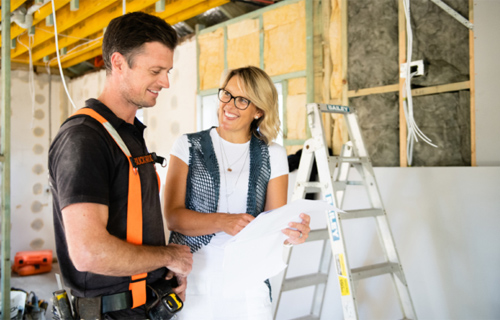Renovating a house with asbestos

Asbestos was widely used in construction before 1980 and, as a consequence, houses built or renovated prior to that year are very likely to contain it in the walls and roofs, as well as around pipes. However, asbestos-containing products are relatively safe as long as they are in good condition and left undisturbed. They are dangerous only when damaged, as asbestos fibers become airborne and can easily be inhaled subsequently. Once they reach the lungs, these toxic fibers increase the chances of developing serious illnesses like mesothelioma or lung cancer significantly.
If in the past most people diagnosed with asbestos-related diseases had been exposed to asbestos at work, the situation is a lot different nowadays, as asbestos exposure has been found to occur during DIY renovations, too. Recent studies have shown that a growing number of people develop asbestos-related conditions due to non-occupational exposure, primarily as a result of performing home renovation.
Asbestos exposure rates
Recent studies found that asbestos exposure commonly happens during home renovations. More than 400 people are diagnosed with mesothelioma every year in Australia alone, and more than 36% of these people are home renovators.
Moreover, over 55% of DIY renovators were exposed to asbestos while performing their job and approximately 40% of them reported that their partner and children were also exposed during the DIY home renovation process. Experienced renovators, however, turned out to be less susceptible to getting themselves and their families exposed to asbestos.
Meanwhile, in the United States, asbestos kills more than 10,000 people annually as a result of various types of exposure.
How to approach a renovation project for houses which contain asbestos
The management of asbestos-containing products has become a very important matter since the mineral's ability to cause serious health problems was discovered. Therefore, in order to minimize the risk of asbestos exposure, any renovation or demolition process must be done according to local rules and state regulations concerning such activities. If you are planning to have your house renovated, here is some advice to help you do it correctly and safely:
- Have an asbestos inspection done before the renovation. It is essential to know which products in your house contain asbestos or are likely to contain it. According to EPA, any substance which contains even as little as 1% asbestos is considered an asbestos-containing material. These products need to be tested by a certified laboratory in order to find out whether they need to be removed or not.
- Notify EPA when necessary. Certain circumstances require owners to notify EPA about projects which involve chancing the structure of houses which contain asbestos. When it comes to renovation projects, EPA must be notified if the amount of damaged asbestos-containing materials which need to be removed is:
- >79 meters for pipes
- >14.5 square meters for other components of the house
- >1.05 cubic meters for components whose length cannot be measured
- Make sure you comply with your state's laws regarding asbestos. Each state has its particular regulations and guidelines for asbestos management and disposal. Following these laws will help you stay safe and out of trouble.
Let professionals do the hard work
Whether you want to renovate your house or would just like to remove the asbestos-containing materials from your dear home, always contact experienced people to help you out. Work with a licensed abatement company and do not forget to have your house properly inspected for asbestos before starting the renovation process.
